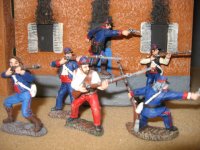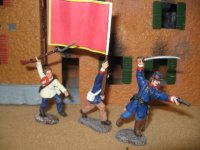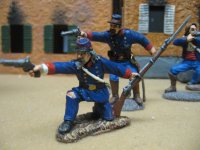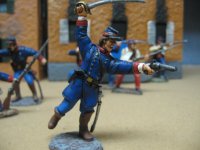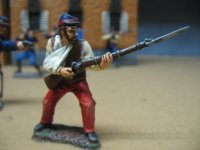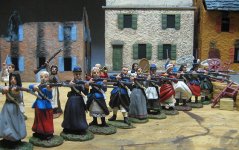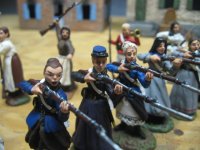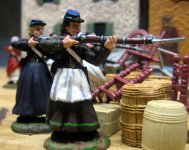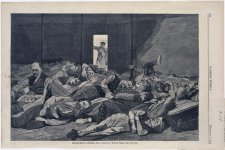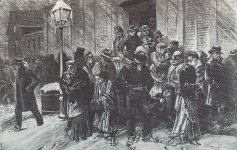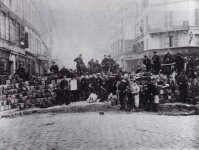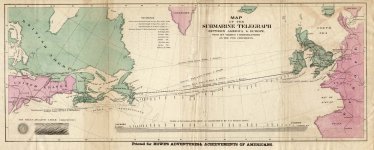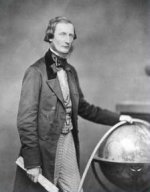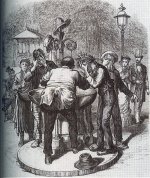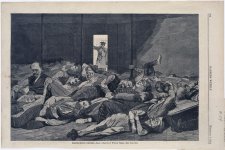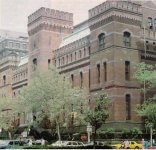You are using an out of date browser. It may not display this or other websites correctly.
You should upgrade or use an alternative browser.
You should upgrade or use an alternative browser.
Paris Commune Garde Mobile conversions (1 Viewer)
- Thread starter Scott
- Start date
Napoleon1er
2nd Lieutenant
- Joined
- Oct 11, 2010
- Messages
- 3,079
May 28, 1871
Down to their last bullets in their outdated muzzle loaders, the rag tag Communards make a last stand in the streets of Paris. TSSD conversions.
View attachment 78105View attachment 78106View attachment 78107View attachment 78108View attachment 78109
Very nice Scott! Can we get more info on the process of how you made these guys? With these figures, who needs the K&C Les Miserables set?!?!?!??!
-Sandor
Scott
Major
- Joined
- Jan 26, 2008
- Messages
- 6,057
Thanks for the nice comments folks.
A couple of the figures are "stock" and painted to look like Garde Mobile. The others are cut and pasted with 2 part putty and paper details added. My disappointment is that there are no plastic figures even close to 1870 French Regulars to oppose them.
One could use Conte's Mexicans as French regulars for the 1830's Les Miz barricade fights. I'd graft some flintlocks and top hats onto TSSD troops for Marius's pals.
A couple of the figures are "stock" and painted to look like Garde Mobile. The others are cut and pasted with 2 part putty and paper details added. My disappointment is that there are no plastic figures even close to 1870 French Regulars to oppose them.
One could use Conte's Mexicans as French regulars for the 1830's Les Miz barricade fights. I'd graft some flintlocks and top hats onto TSSD troops for Marius's pals.
Scott
Major
- Joined
- Jan 26, 2008
- Messages
- 6,057
Mr Scott
Really excellent painted conversions.
They show a lot work done well.
Thanks for posting them.
Thank you and you are welcome.
Napoleon1er
2nd Lieutenant
- Joined
- Oct 11, 2010
- Messages
- 3,079
Thanks for the nice comments folks.
A couple of the figures are "stock" and painted to look like Garde Mobile. The others are cut and pasted with 2 part putty and paper details added. My disappointment is that there are no plastic figures even close to 1870 French Regulars to oppose them.
One could use Conte's Mexicans as French regulars for the 1830's Les Miz barricade fights. I'd graft some flintlocks and top hats onto TSSD troops for Marius's pals.
By Napoleon I swear I will find you some troops to oppose them! I swear I saw something close the other day...
Scott
Major
- Joined
- Jan 26, 2008
- Messages
- 6,057
PolarBear
Major
- Joined
- Feb 24, 2007
- Messages
- 6,706
Scott
A fascinating scene and subject, very well executed. I see from your blog that there were Vivandieres there too.
The Paris Commune resonated with Americans during the 1870s and in the following posts I will show how and why this was so and the role played by technology (the Transatlantic Cable) and the popular press (pictorial newspapers). This material is part of a book I am working on called Winslow Homer & The Empire of Cotton 1854-1910.
Randy
A fascinating scene and subject, very well executed. I see from your blog that there were Vivandieres there too.
The Paris Commune resonated with Americans during the 1870s and in the following posts I will show how and why this was so and the role played by technology (the Transatlantic Cable) and the popular press (pictorial newspapers). This material is part of a book I am working on called Winslow Homer & The Empire of Cotton 1854-1910.
Randy
PolarBear
Major
- Joined
- Feb 24, 2007
- Messages
- 6,706
The February 7, 1874 issue of Harper’s Weekly included an illustration by Winslow Homer entitled Station-House Lodgers. I would like to suggest that the illustration must be considered specifically in relation to events resulting from the American economic Depression of 1873. This financial downturn led to mass layoffs of the American workforce and a significant increase in homeless individuals, especially in urban areas such as New York City where Homer maintained a studio and was working at the time. The individuals lying on the police station’s floor are not meant to represent criminals but are the homeless and unemployed resulting from the 1873 Depression. New York City’s charities did not have the funds nor space to provide nighttime lodgings for the thousands who had lost their jobs and found themselves destitute and out on the street. In response, the city’s police stations provided sleeping space each night especially during the cold winter months. Harper’s February publication date would suggest that this is the case here.
Attachments
PolarBear
Major
- Joined
- Feb 24, 2007
- Messages
- 6,706
Below is an illustration of a similar subject by Fernando Miranda published three years later in Frank Leslie’s Illustrated Newspaper of February 10, 1877 entitled New York City—Early Morning At a Police Station and showing night lodgers (in this example both men and women) similar to Homer’s being turned out into the cold winter morning after a night’s lodging.
Attachments
PolarBear
Major
- Joined
- Feb 24, 2007
- Messages
- 6,706
The presence of all these unemployed individuals roaming the streets and even the countryside during the decade instilled fear into middle and upper class Americans. This fear was enhanced by the newspapers and journals of the period which compared the American situation to recent history in Europe, specifically the Paris Commune of 1871, an uprising by French anarchists and Marxists after France was defeated by Germany in the Franco-Prussian War. The leaders of the commune held control over Paris from March 28 to May 28, 1871. Americans were now worried that a similar situation might develop within their own cities.
Paris Commune 1871
Paris Commune 1871
Attachments
PolarBear
Major
- Joined
- Feb 24, 2007
- Messages
- 6,706
According to historian Jack Beatty, Americans awareness of the events in France had received daily and detailed coverage in the American press. This was a result of the Transatlantic telegraph cable that had been established between 1858-1866 under the aegis of inventor Cyrus Field. The media had the latest stories to tell their public (and frighten them as well).
Attachments
PolarBear
Major
- Joined
- Feb 24, 2007
- Messages
- 6,706
The men lying on the floor of Homer’s Station-House were described by the national press as tramps since many of them were on the road traveling across the country in search of work or a meal. During the 1870s and 1880s the news media whipped up a “tramp scare” that suggested to the public that these homeless and destitute men might be capable of murder, theft or even political anarchy. Socialist and Marxist ideas were in the air and Americans uneasily associated this turn of events with what had happened in France. Many of the tramp stories in the press were not based on fact but simply reported on rumors circulating among the states.
Frank Leslie’s Illustrated Newspaper July 21, 1877 (cover)
“New York City---A tramp’s morning ablutions—An early morning scene in Madison Square”: (artist unknown)
Frank Leslie’s Illustrated Newspaper July 21, 1877 (cover)
“New York City---A tramp’s morning ablutions—An early morning scene in Madison Square”: (artist unknown)
Attachments
PolarBear
Major
- Joined
- Feb 24, 2007
- Messages
- 6,706
On January 13, 1874, 7000 unemployed New York workers massed in the city’s Tomkins Square for a meeting that had been approved by the Department of Parks. The city’s police board, however, asked the Parks Department to cancel the permit the night before it was to be held. When the workers (who had not been informed nor were there signs in the park) arrived the next morning, they were greeted by 1600 policeman (many of whom were mounted) who brutally attacked them with clubs and drove them from the park. On January 31, 1874 Frank Leslie’s Illustrated Newspaper published a wood engraving with an incendiary (and false) headline: “The Red Flag in New York—Riotous communist workingmen driven from Tompkins Square by the mounted police, Tuesday, January 13th, 1874” by artist Matthew Sommerville Morgan.
Illustration from Frank Leslie’s Illustrated Newspaper January 31, 1874:
Illustration from Frank Leslie’s Illustrated Newspaper January 31, 1874:
Attachments
PolarBear
Major
- Joined
- Feb 24, 2007
- Messages
- 6,706
It is interesting that just seven days later Harper’s Weekly (Leslie’s competitor) published Homer’s scene of Station-House Lodgers shown peacefully asleep within the walls of one of the police stations set aside for this purpose. Homer’s 1874 wood engraving must be seen within the larger context of Homer’s interest in labor and the plight of workers ranging from the cotton plantations of the American South to the textile mills of New England during the 1860s and 1870s.
Attachments
PolarBear
Major
- Joined
- Feb 24, 2007
- Messages
- 6,706
In post Civil War America there was extensive building of armories in the big cities of most states to house the state militias that many felt would be needed to prepare for possible riots and violence as the gap between the very rich and the very poor grew exponentially.
NYC Park Avenue 7th Regimental Armory
NYC Park Avenue 7th Regimental Armory
Attachments
jazzeum
Four Star General
- Joined
- Apr 23, 2005
- Messages
- 38,379
Scott,
Very well done but great idea for a diorama, an inspirational moment in history, something you won't likely to be seen done by a manufacturer.
It seems most collectors prefer to just make pretty little scenes, avoiding or forgetting the ideas behind their toy soldiers. I'm glad you haven't done that. Bravo.
Brad
Very well done but great idea for a diorama, an inspirational moment in history, something you won't likely to be seen done by a manufacturer.
It seems most collectors prefer to just make pretty little scenes, avoiding or forgetting the ideas behind their toy soldiers. I'm glad you haven't done that. Bravo.
Brad
fishead19690
Command Sergeant Major
- Joined
- Nov 3, 2005
- Messages
- 2,555
May 28, 1871
Down to their last bullets in their outdated muzzle loaders, the rag tag Communards make a last stand in the streets of Paris. TSSD conversions.
View attachment 78105View attachment 78106View attachment 78107View attachment 78108View attachment 78109
Scott, Great job on the conversions!^&cool And nice to see you painting again! Keep them coming I love it.^&cool Paint up and convert some more and give us a bigger diorama!^&cool
Users who are viewing this thread
Total: 2 (members: 0, guests: 2)


